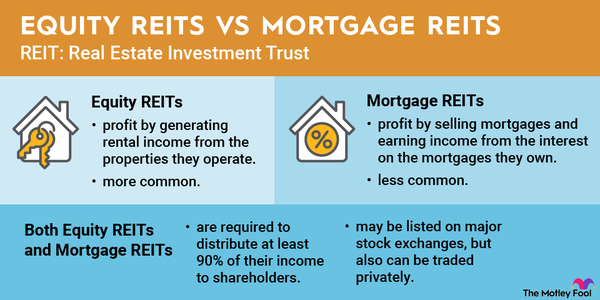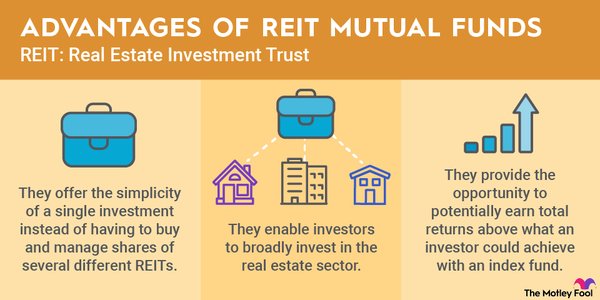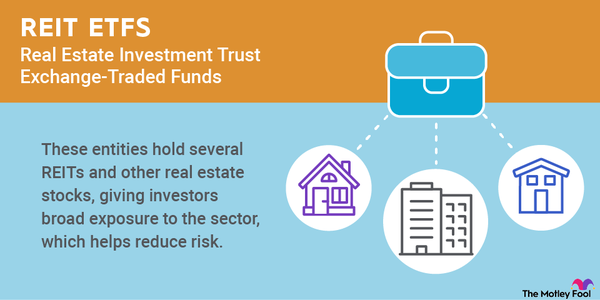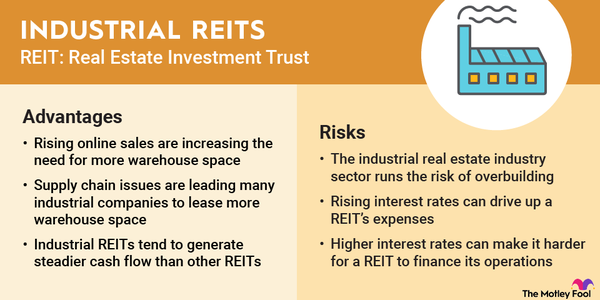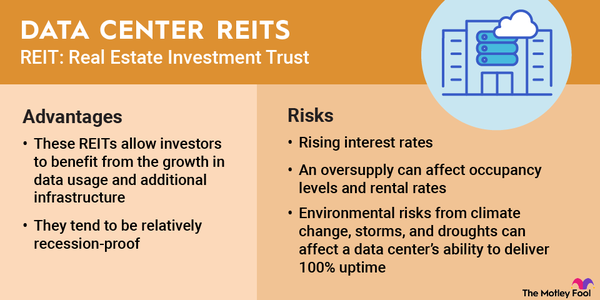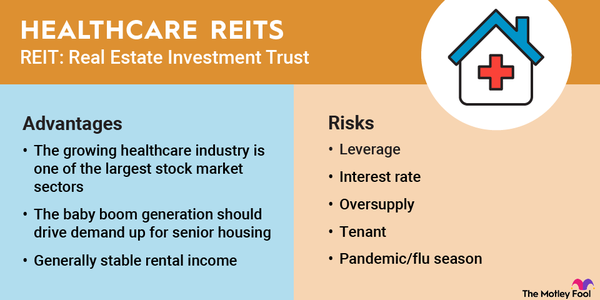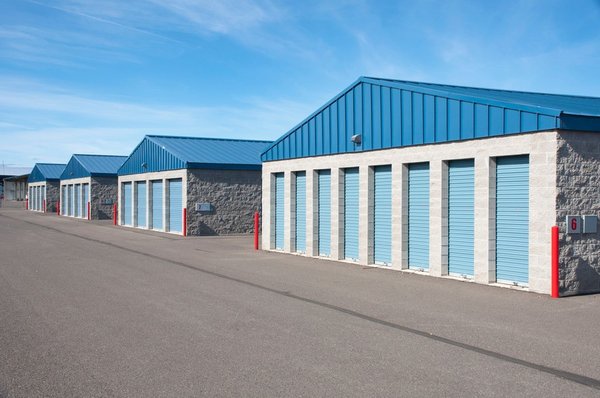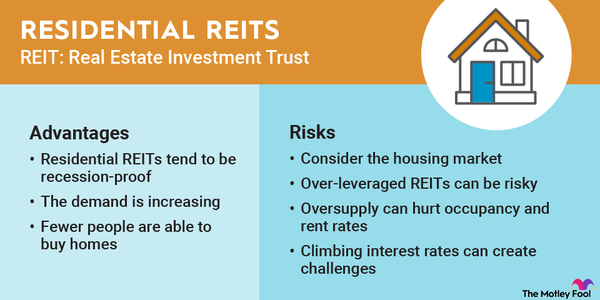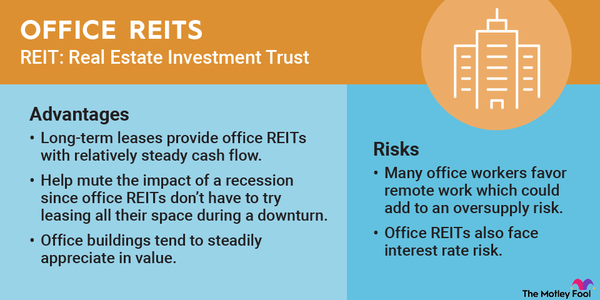Infrastructure real estate investment trusts (REITs) are entities that own and manage data infrastructure-related real estate, such as cell towers. These property types are essential to the economy because they help support the movement and storage of data.
Here's a closer look at infrastructure REITs, their advantages and risks, and some companies that investors should consider.

Understanding REITs
Understanding infrastructure REITs
Infrastructure is one of the unique real estate investments. It typically doesn't include traditional commercial real estate such as buildings or land. However, it's still physical property leased to tenants. The most common infrastructure owned by REITs includes telecommunications assets such as cell towers, fiber optic networks, and small cell nodes.
Infrastructure REITs make money by leasing their infrastructure to tenants, typically under long-term contracts. The long-term contracts supply the REITs with steady cash flows to support dividend payments.
Advantages
Advantages of investing in infrastructure REITs
Infrastructure REITs have several benefits:
- Stable demand: Telecom companies need infrastructure to support their networks.
- Steady cash flow: Infrastructure REITs typically sign long-term leases with mobile carriers and other customers that supply them with recurring revenue.
- Growing demand: An increasingly digital economy needs more infrastructure to support faster networks like 5G. That enables infrastructure REITs to invest capital to grow their portfolios.
Risks
Risks of investing in infrastructure REITs
While infrastructure REITs typically benefit from stable and growing demand, they're not without risk. Some of the risks of investing in these REITs include:
- Tenant risks: Industry consolidation in the U.S. has enabled some mobile carriers to reduce their leased infrastructure because they don't currently need as much capacity. Meanwhile, financial troubles from some international mobile carriers have affected their ability to pay rent on their leased infrastructure.
- Interest rate risk: This issue is common to the REIT sector. Rising interest rates can increase interest expenses if a REIT has a lot of floating-rate debt or significant near-term debt maturities. In addition, rising interest rates tend to weigh on REIT stock prices because they're yield-focused investments. As REIT stock prices fall, dividend yields rise to compensate investors for their higher risk profiles compared to bonds.
- Financial risk: Infrastructure REITs tend to borrow a lot of money to fund their expansion. If they borrow too much, it can hamper their ability to pay dividends.
REIT list
Four infrastructure REITs to consider in 2025
According to the National Association of Real Estate Investment Trusts (NAREIT), there were four publicly traded telecom infrastructure REITs as of mid-2025. Here's a closer look at this quartet of REITs focused on communications and data infrastructure:
| Name and ticker | Market cap | Dividend yield | Industry |
|---|---|---|---|
| American Tower (NYSE:AMT) | $99 billion | 3.13% | Specialized REITs |
| Crown Castle (NYSE:CCI) | $45 billion | 5.55% | Specialized REITs |
| SBA Communications (NASDAQ:SBAC) | $24 billion | 2.37% | Specialized REITs |
| Unity Group Llc (NASDAQ:UNIT) | $2 billion | 0.00% | Diversified Telecommunication Services |
1. American Tower
American Tower has grown out of its name over the years. The leading REIT has almost 150,000 communications sites spread across more than two dozen countries. In addition, it owns a growing portfolio of U.S. data centers. The company's international expansion and move into data centers have diversified its portfolio and transformed it into a global leader in data infrastructure.
American Tower has become one of the largest global REITs. It has steadily acquired tower portfolios from telecom companies, built new towers, and added tenants to its sites. This three-pronged growth strategy has enabled the company to increase its revenue and adjusted funds from operations (FFO) at a 9% compound annual rate over the past decade. Meanwhile, the REIT has increased its dividend by more than 20% annually since 2014.
With its more recent move into data centers and a strong balance sheet, American Tower should be able to continue growing at a healthy rate for the next several years.
2. Crown Castle
Crown Castle has more than 40,000 communications towers in the U.S. In addition, the company had 90,000 route miles of fiber supporting 105,000 small cell nodes (on air or under contract) and fiber solutions across every major U.S. market. These assets are crucial to supporting 5G networks.
Crown Castle has invested tens of billions of dollars in acquiring and building out fiber and tower assets over the past decade. The company sees another decade-long investment cycle ahead as its customers develop next-generation wireless networks such as 5G.
However, the company agreed to sell its fiber and small cell assets in early 2025 due to the lower returns generated by those investments. Closing this sale will allow the company to repurchase stock, repay debt, and focus on growing its U.S. tower business.
3. SBA Communications
SBA Communications owns a global portfolio of wireless communications infrastructure, including towers, buildings, rooftops, distributed antenna systems, and small cell nodes. As of mid-2025, its portfolio consisted of more than 39,000 communications sites throughout the Americas and Africa.
SBA Communications generates revenue from site leasing and site development. The company leases space on its towers and other structures to wireless service providers under long-term contracts to house their communications equipment. In addition, the REIT assists wireless service providers in developing their networks through site acquisition, construction, and equipment installation. These two businesses have enabled the company to steadily increase its revenue, earnings, and dividend over the years.
4. Uniti Group
Uniti Group closed its merger with Windstream Holdings to create a premier digital infrastructure company in August 2025. The deal combined Uniti's national wholesale-owned fiber network with Windstream's fiber-to-the-home business. As part of the transaction, the new company will convert from a REIT to a taxable C-corporation.
While Uniti is no longer a REIT, it may restructure some of its subsidiaries to qualify as a REIT to provide additional tax savings and preserve its strategic optionality. Further, the company still focuses on owning and investing in digital infrastructure (fiber), which should make it appealing to investors interested in this space.
Related investing topics
Telecom infrastructure REITs see a lot of growth ahead
Infrastructure is crucial to the global economy. That's providing REITs with steady demand for their existing infrastructure and ample opportunities to expand. With infrastructure spending expected to increase in the coming years, these infrastructure REITs should be able to continue growing at above-average rates.
FAQ
FAQ on investing in infrastructure REITs
What is the largest infrastructure REIT?
American Tower is the largest infrastructure REIT (and one of the largest REITs in the world). Its market capitalization is roughly double that of its closest peer (Crown Castle).
Is investing in infrastructure a good idea?
Yes, investing in infrastructure is a good idea. Demand for infrastructure is stable and growing. Companies that own infrastructure (such as REITs) should produce stable and growing cash flow to support their dividends.
What factors influence the performance of Infrastructure REITs?
Several factors influence the performance of infrastructure REITs, including their ability to grow their earnings, interest rate fluctuations, tenant issues, and their financial profiles.
Are Infrastructure REITs suitable for long-term investment?
Yes, infrastructure REITs are suitable for long-term investment. Infrastructure REITs typically generate durable cash flows backed by long-term leases. Additionally, they benefit from resilient long-term growth drivers as demand for infrastructure is stable and steadily increasing.











